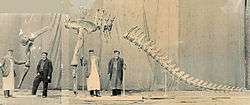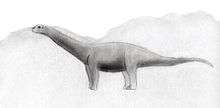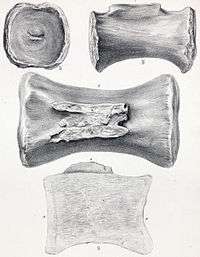Cetiosauriscus
- Not to be confused with another sauropod dinosaur, Cetiosaurus.
| Cetiosauriscus Temporal range: Middle Jurassic, 165–161 Ma | |
|---|---|
 | |
| Composite photo of the holotype | |
| Scientific classification | |
| Kingdom: | Animalia |
| Phylum: | Chordata |
| Class: | Reptilia |
| Clade: | Dinosauria |
| Order: | Saurischia |
| Suborder: | †Sauropodomorpha |
| Clade: | †Eusauropoda |
| Genus: | †Cetiosauriscus von Huene, 1927 |
| Species: | †C. stewarti |
| Binomial name | |
| Cetiosauriscus stewarti Charig, 1980 | |
Cetiosauriscus (/siːθiːuːsɒrɪskʌs/ meaning "whale lizard like" i.e. "Cetiosaurus-like") is an extinct genus of sauropod dinosaur. It lived in the Callovian (Middle to Late Jurassic Period) of England (about 165 to 161 million years ago [mya]). Cetiosauriscus was a quadrupedal, herbivorous, saurischian, and was possibly the earliest diplodocid. It was named by Friedrich von Huene in 1927, for the species Cetiosaurus leedsi. Before 1993 it was shown that C. leedsi was not a Cetiosauriscus species, so that year Alan J. Charig sent a petition to the ICZN to designate C. stewarti as the type species. The remains include a series of vertebra, a hind leg, a partial sacrum, and a front leg. A potential additional specimen includes a diplodocid whiplash tail. Cetiosauriscus has, over time, been classified in Cetiosauridae, Diplodocidae, and Mamenchisauridae. It lived alongside Sarcolestes, Callovosaurus, and Lexovisaurus.
Description
Cetiosauriscus was a relatively small quadrupedal, herbivorous sauropod. It is estimated by Gregory S. Paul that Cetiosauriscus stood 6 metres (20 ft) high and was 15 metres (49 ft) in length, weighing about 4 tonnes (3.9 long tons; 4.4 short tons).[1] Another estimate, by Thomas R. Holtz Jr., had Cetiosauriscus standing up to 15 metres (49 ft) long and weighing roughly 14 tonnes (14 long tons; 15 short tons).[2]
The only overlapping material between BMNH R3078 and the holotype of Cetiosauriscus leedsi is an ilium. However, in both specimens the ilium was preserved in insufficient ways. Since the only overlapping material was impossible to compare, Charig found that BMNH R3078 was of a different species and he named it Cetiosauriscus stewarti.[3][4] Metacarpal 1 is short and massive, with the prominent process on the lower part of the posterior margin of the lateral face, a characteristic of the diplodocoids Diplodocus, Apatosaurus, Cetiosauriscus and Dicraeosaurus.[5]
Huene felt the vertebrae of BMNH R3078 had proportions different enough from Cetiosaurus to warrant its own genus. Also, the fusion of centra with minimal osseous proliferation is manifest in the caudal vertebrae of Cetiosauriscus.[6] The Cetiosaurus specimen OUMNH J13695 has a low horizontal ridge on each of its lateral surfaces, creating a slightly subhexagonal transverse cross-section, and is also seen on Cetiosauriscus, as well as the anterior caudals of Haplocanthosaurus, and caudals 15 to 30 of Omeisaurus. Also, the area around the periphery of each articular face is flattened, creating a 'bevelled' appearance, and also occurs in Cetiosaurus and Haplocanthosaurus.[7] A whiplash tail was apparently found in the same deposits but it is not certain it belongs to the same individual. Since there is no overlapping material, this assignment to Cetiosauriscus should be treated with caution.[4][8]
Classification
Von Huene originally classified Cetiosauriscus as a member of the Cardiodontinae within the Cetiosauridae. In 1978, McIntosh concluded it belonged to the Diplodocidae because of double chevrons under its caudal vertebrae, the short front legs and a tabular bump on the lower end of its first metatarsal.[9] This would make Cetiosauriscus the oldest known diplodocid. Two years later, Charig came to the same conclusion of Diplodocid origins.[10] If Cetiosauriscus is a diplodocid, it moves the origin of Diplodocidae to the Callovian. If not, Diplodocidae is restricted to less than 10 million years.[11] Many recent analysis's have found Cetiosauriscus in Eusauropoda.[7][12] The recent analysis done by Darren Naish and M. Martill in 2007 has suggested it could have belonged to the Mamenchisauridae instead, a group which also features double chevrons.[8] Cetiosauriscus was included in the phylogenetic analysis of Carrano (2005), where it was found to be a basal diplodocoid near Amphicoelias.[13]

The below cladogram was published by Tschopp et al. in 2015, during a specimen-level analysis of Diplodocoidea.[14]
| |
| ||||||||||||||||||||||||||||||||||||||||||||||||||||||||||||||||||||||||||||||
| |
Distinguishing characteristics
A characteristic that distinguishes Cetiosauriscus is that it has axially concave summits on the cranial and middle caudal neural spines.[4] Barosaurus differs from it in having a more complex sculpting laterally and ventrally in the caudals; in having a larger humerus-femur ratio; and in having differently developed chevrons.[5]
Paleoecology
Cetiosauriscus lived during the Callovian, an epoch in the Middle Jurassic, about 165 to 161 mya,[2] of the Lower Member of the Oxford Clay Formation. Other genera found within the same member include the indeterminate brachiosaurid "Ornithopsis" leedsi; the stegosaurid Lexovisaurus; the indeterminate ankylosaurian Sarcolestes; the ornithopod Callovosaurus (previously Camptosaurus); an unnamed euornithopod; and dinosaur eggs. The theropod Eustreptospondylus is also from the formation, but the Middle Member, along with indeterminate theropods and sauropods, and it may have preyed upon Cetiosauriscus.[4]
Discovery and naming
In 1927, German paleontologist Friedrich von Huene new genus for Cetiosaurus leedsi and its specimens BMNH R.1984–1988 and BMNH R.3078, Cetiosauriscus, after identifying sufficient differences from the former genus. He based his new name off Cetiosaurus ("whale lizard") by adding the Latin suffix iscus, meaning "like", translating fully to "whale lizard like".[3] In 1939 Huene also moved "Ornithopsis" greppini, a species from Switzerland, to Cetiosauriscus, creating the new combination "Cetiosauriscus" greppini.[4] In 1980 Alan J. Charig concluded that due to lack of comparable bones, BMNH R.3078 could not be assigned to the same taxon as BMNH R1984–1988, and created a new species for the former: Cetiosauriscus stewarti. The specific name was chosen to honour Sir Ronald Stewart, the chairman of the London Brick Company, which owned the clay pit the fossils had been found in. Furthermore, Charig considered both C. leedsi and "C." greppini nomina dubia, and C. stewarti valid.[10] In 1993, Charig decided to send a petition to the International Commission on Zoological Nomenclature (ICZN), to ask them to change the type species of Cetiosauriscus from the dubious C. leedsi, to the taxonomically stable C. stewarti.[3] This was accepted by the ICZN in 1995, making BMNH R.3078, the holotype of C. stewarti, the basis for Cetiosauriscus.[15] C. stewarti is senior synonym in partim of Ornithopsis leedsi (=Cetiosauriscus leedsi; Cetiosaurus leedsi),[4] as its holotype was once referred to this taxon.[3]
BMNH R.3078 was found at Peterborough, Cambridgeshire, in strata of the Upper Oxford Clay and consists of a series of vertebrae from the rear half of the skeleton. Other remains, including a front leg with fossilized cartilage in its joint, a hind leg, and a partial sacrum have been referred to and accepted as C. stewarti. A whiplash tail from the same locality was thought by Charig as possibly belonging to Cetiosauriscus, but the assignment is not fully accepted by paleontologists.[3][8][16] With that much material, Cetiosauriscus is one of the most complete sauropods from the United Kingdom.[15]
Historic species
Over the years, multiple species that have once been assigned to Cetiosauriscus have been considered invalid, reassigned, or sunk as a synonym:[4]
- Cetiosauriscus leedsi: In 1887, John Whittaker Hulke named a new species of sauropod, Ornithopsis leedsi. He designated BMNH R.1984–1988 as its type series, bones from the collections found by Alfred Nicholson Leeds. In 1905, Harry Govier Seeley made a suggestion to Arthur Smith Woodward, who took Seeley's advice and renamed O. leedsi, Cetiosaurus leedsi. Woodward also referred an additional specimen to the species, BMNH R.3078. The specimen was mounted and displayed for many years in the Dinosaur Gallery of the British Museum of Natural History (now the Natural History Museum) in London.[3] An additional specimen, BMNH R.3706, referred to C. leedsi under the genus Cetiosaurus, includes some ribs, and may belong to a pliosaur. All referrals of C. leedsi outside of Ornithopsis are no longer accepted, and the species is thought to represent a new indeterminate brachiosaurid.[17]

- Cetiosauriscus greppini: Another species previously in Ornithopsis that was included in Cetiosauriscus, O. greppini was reclassified by Huene in 1929. "Cetiosauriscus" greppini was later renamed again by Huene in 1932 as Cetiosaurus greppini, a junior synonym of "Cetiosauriscus" greppini. "Cetiosauriscus" greppini is from the Reuchenette Formation, a formation of Early Kimmeridgian age. It is known from three individuals, the holotype being the most complete. "Cetiosauriscus" greppini differs from Cetiosauriscus stewarti by having caudal transverse processes that are anteroposteriorly flat and have a distinct dorsal wing-like expansion. It also differs in having anterior posterior centrodiapophyseal laminae situated ventrally from the anterior caudal transverse process, a coracoid with a rounded outline and with a notch ventrally to the glenoid articular face, remarkably straight shafts of humerus and femur, a distal end of the humerus with a higher medial than lateral hemicondyle, a more proximally placed 4th trochanter, and a longer and straighter ischium shaft. These characters certify that both taxa differ on the generic level.[15] The discovery of cartilaginous tissue relatively proximal to the end of the humerus of "Cetiosauriscus" greppini has suggested that the cartilage caps of sauropods may have been larger than predicted by an Alligator CCF and that the cartilage caps extended fairly far onto the metaphysics of some long bones.[18] "Cetiosauriscus" greppini is known from a femur with bite marks on it. The marks strongly match the teeth of Machimosaurus, meaning that Machimosaurus scavenged or possibly regularly preyed on animals like Cetiosauriscus.[19] "Cetiosauriscus" greppini is now considered to be Eusauropoda incertae sedis.[4][7][12][15]

- Cetiosauriscus longus: In 1990, John Stanton McIntosh recombined Cetiosaurus longus as a species of Cetiosauriscus.[9] This classification is not accepted and Cetiosauriscus longus is a junior objective synonym of Cetiosaurus longus because it cannot be proven to possess any characteristic autapomorphies of Cetiosauriscus.[4] In 1993, Charig found the species to be a nomen dubium.[3]
- Cetiosauriscus glymptonensis: Phillips (1871) named Cetiosaurus glymptonensis on the basis of nine middle-distal caudal centra from the Forest Marble Formation of Oxfordshire, England.[7] In 1990, McIntosh renamed Cetiosaurus glymptonensis as "Cetiosauriscus" glymptonensis.[9] Upchurch and Martin (2003) reexamined this material and concluded that it was potentially a diplodocid and was distinct from both Cetiosaurus oxoneinsis and Cetiosauriscus. The centra are elongated, as occurs in many diplodocids. The lateral surfaces of the centra bear two parallel horizontal ridges, causing the centra to be octagonal in transverse cross-section. The upper ridge is also present in Cetiosauriscus but the lower ridge is unique.[4] This was later renamed into Cetiosauriscus.[7] "Cetiosauriscus" glymptonensis is diagnosed by middle-distal caudal centra having a distinct horizontal ridge approximately one-third the way up the lateral surface.[4] "Cetiosauriscus" glymptonensis is considered to be Eusauropoda incertae sedis, in need of a new genus.[4][7][12]
References
- ↑ Paul, G.S. (2010). Princeton Field Guide to Dinosaurs. Princeton University Press. p. 189. ISBN 978-0-691-13720-9.
- 1 2 Holtz, T.R. Jr. (2011). Dinosaurs: The Most Complete, Up-to-date Encyclopedia for Dinosaur Lovers of All Ages (PDF). Random House. ISBN 978-0-375-82419-7.
- 1 2 3 4 5 6 7 Charig, A.J. (1993). "Case 2876. Cetiosauriscus von Huene, 1927 (Reptilia, Sauropodomorpha): designation of C. stewarti Charig, 1980 as the type species". Bulletin of Zoological Nomenclature. 50 (4): 282–283.
- 1 2 3 4 5 6 7 8 9 10 11 12 Weishampel, David B.; Dodson, Peter; Osmolska, H., eds. (2004). "The Dinosauria: Second Edition". University of California Press: 265–784. ISBN 0-520-24209-2.
- 1 2 Apesteguía, S. (2005). "Evolution of the titanosaur metacarpus". In Carpenter, Kenneth; Tidwell, Virginia. Thunder-Lizards: The Sauropodmorph Dinosaurs. Indiana University Press. pp. 321–345. ISBN 0-253-34542-1.
- ↑ Brett-Surman, M.K.; Holtz, T.R.; Farlow, J.O. (2012). The Complete Dinosaur (Second ed.). Indiana University Press. ISBN 978-0-253-35701-4.
- 1 2 3 4 5 6 Upchurch, P.; Martin, J. (2003). "The anatomy and taxonomy of Cetiosaurus (Saurischia: Sauropoda) from the Middle Jurassic of England". Journal of Vertebrate Paleontology. 23: 208–231. doi:10.1671/0272-4634(2003)23[208:taatoc]2.0.co;2.
- 1 2 3 Naish, D.; Martill, M. (2007). "Dinosaurs of Great Britain and the role of the Geological Society of London in their discovery: basal Dinosauria and Saurischia". Journal of the Geological Society. 164: 493–510. doi:10.1144/0016-76492006-032.
- 1 2 3 McIntosh, J.S. (1990). "Sauropoda". In Weishampel, David B.; Dodson, Peter; Osmólska, H. The Dinosauria. University of California Press. pp. 345–401. ISBN 978-0-520-25408-4.
- 1 2 Charig, A.J. (1980). "A diplodocid sauropod from the Lower Cretaceous of England". In Jacobs, L. L. Aspects of Vertebrate History: Essays in Honor of Edwin Harris Colbert. Museum of Northern Arizona Press. pp. 231–244.
- ↑ Bonaparte, J.F.; Mateus, O. (1999). "A new diplodocid, Dinheirosaurus lourinhanensis gen. et sp. nov., from the Late Jurassic beds of Portugal". Revista del Museo Argentino de Ciencias Naturales. 5 (2): 13–29. ISSN 0524-9511.
- 1 2 3 Whitlock, J.A. (2011). "The phylogeny of Diplodocoidea (Saurischia: Sauopoda)". Zoological Journal of the Linnean Society. 161: 872–915. doi:10.1111/j.1096-3642.2010.00665.x.
- ↑ Carrano, M.T. (2005). The Evolution of Sauropod Locomotion. University of California Press. ISBN 978-0-520-24623-2.
- ↑ Tschopp, E.; Mateus, O.; Benson, R.B.J. (2015). "A specimen-level phylogenetic analysis and taxonomic revision of Diplodocidae (Dinosauria, Sauropoda)". PeerJ. 3: e857. doi:10.7717/peerj.857.
- 1 2 3 4 Shwartz, D.; Meyer, C.A.; Wings, O.; Le Loeuff, J. (2007). "Revision of Cetiosauriscus greppini – new results and perspectives". Fifth Meeting of the European Association of Vertebrate Paleontologists Abstract Volume: 57–58.
- ↑ von Huene, F. (1927). "Sichtung der Grundlagen der jetzigen Kenntnis der Sauropoden" [Review of the elements of the present knowledge of sauropods]. Eclogae Geologica Helveticae. 20: 444–470.
- ↑ Moody, R.T.J.; Buffetaut, E.; Naish, D.; Martill, D.M. (2010). Dinosaurs and Other Extinct Saurians: A Historical Perspective. Geological Society. ISBN 978-1-86239-311-0.
- ↑ Shwartz, D.; Wings, O.; Meyer, C.A. (2007). "Super sizing the giants: the first cartilage preservation at a sauropod limb joint". Journal of the Geological Society. 164: 61–65. doi:10.1144/0016-76492006-019.
- ↑ Meyer, C.A.; Thuring, C.R. (2003). "Dinosaurs of Switzerland". Comptes Rendus Paleovol. 2 (1): 103–117. doi:10.1016/s1631-0683(03)00005-8.
External links
- "Cetiosauriscus". Fossilworks - Gateway to the Paleobiology Database.
- "Cetiosauriscus stewarti". Fossilworks - Gateway to the Paleobiology Database.
- "Cetiosauriscus". Paleobiology Database: Classic.
- "Cetiosauriscus stewarti". Paleobiology Database: Classic.
- "Genus Cetiosauriscus". PaleoStation.